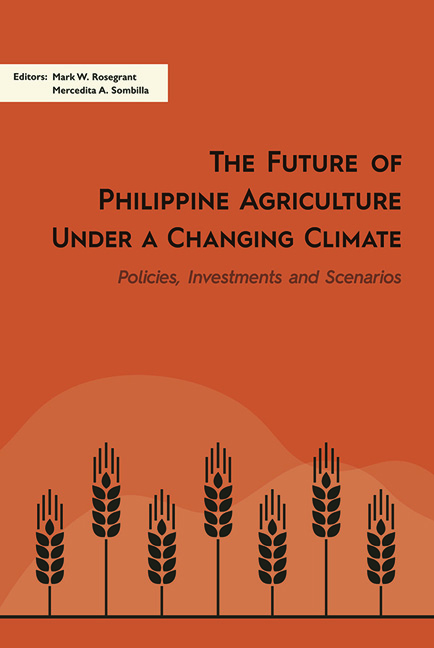Book contents
- Frontmatter
- Contents
- List of Tables
- List of Figures
- List of Appendices
- Preface
- Acknowledgements
- List of Contributors
- PART I Setting up the Scenarios: Current Status and Potential Impacts of Climate Change to Philippine Agriculture
- PART II Climate Change Adaptation Strategies and Sustainability of Philippine Agriculture
- PART III Investments and Supporting Policies to Alleviate Climate Change Impacts to Philippine Agriculture
- PART IV Conclusion
- 12 Summary and Policy Recommendations
- Index
12 - Summary and Policy Recommendations
from PART IV - Conclusion
Published online by Cambridge University Press: 29 May 2019
- Frontmatter
- Contents
- List of Tables
- List of Figures
- List of Appendices
- Preface
- Acknowledgements
- List of Contributors
- PART I Setting up the Scenarios: Current Status and Potential Impacts of Climate Change to Philippine Agriculture
- PART II Climate Change Adaptation Strategies and Sustainability of Philippine Agriculture
- PART III Investments and Supporting Policies to Alleviate Climate Change Impacts to Philippine Agriculture
- PART IV Conclusion
- 12 Summary and Policy Recommendations
- Index
Summary
Agriculture's direct share of the Philippines’ gross domestic product (GDP) has fallen over time, from around from 20 per cent in the 1960s to 10 per cent as of 2014 (Chapter 1, this volume). Nevertheless, one-third of the labour force is still employed in agriculture, and 70 per cent of rural poor people depend on the sector and related activities for major shares of their income (Chapter 1, this volume). For these reasons, the medium-term development plans of successive Philippine administrations have consistently acknowledged the need to energize and modernize the agricultural sector in the pursuit of vigorous, broad-based economic growth and development that will generate employment and reduce poverty and inequality. Success in attaining this goal, however, has continued to be elusive. In fact, it has become more challenging due to climate change and the associated increase in the number and severity of natural disasters.
This volume has identified key contributing factors to the complex challenge of developing and modernizing the Philippine agricultural sector, examined how changes in key input resources have affected agricultural growth, discussed the range of additional threats that climate change poses to the sector, quantified recent agricultural losses due to the impacts of climate change, and identified measures to help mitigate these losses under a variety of potential policy scenarios. The purpose of this final chapter is to summarize the key findings of the preceding chapters, and synthesize recommendations on the policy and institutional changes needed to strengthen the sector and enhance its resilience to climate change.
AGRICULTURE's POTENTIAL AS AN ENGINE OF GROWTH AND POVERTY REDUCTION
Past studies analysing the Philippine agricultural sector have noted its weak growth performance despite numerous programmes to invigorate and modernize the sector. Productivity growth — measured in terms of land productivity, commodity yield per hectare (ha), or total factor productivity (TFP) — has slowed over time (Chapters 1 and 5, this volume). This has contributed to the sector's low levels of labour productivity and the high incidence of poverty in rural areas, where 69 per cent of the agricultural labour force remain either unpaid or self-employed (Chapter 1, this volume).
- Type
- Chapter
- Information
- The Future of Philippine Agriculture under a Changing ClimatePolicies, Investments and Scenarios, pp. 537 - 566Publisher: ISEAS–Yusof Ishak InstitutePrint publication year: 2018



